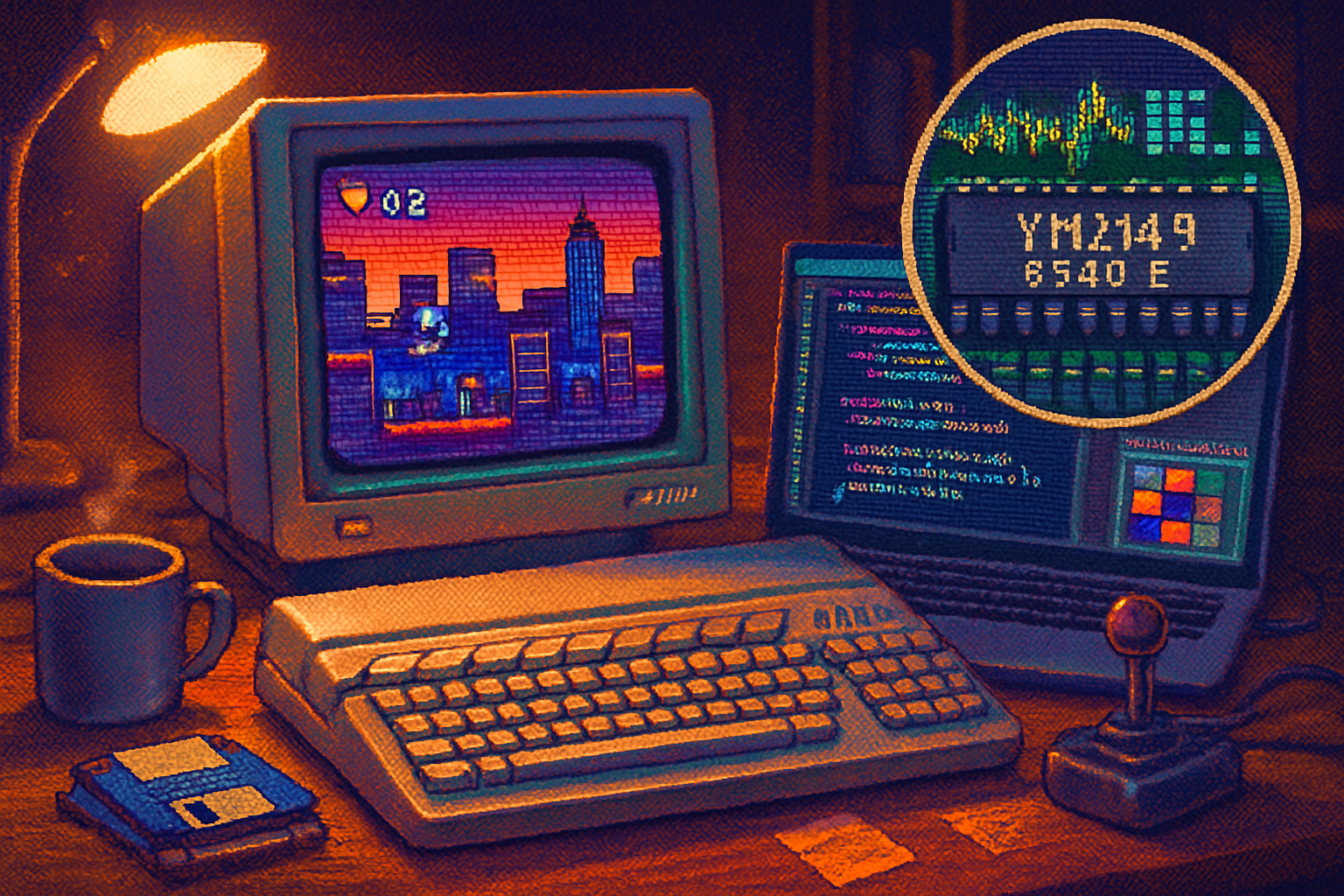· retrotech · 7 min read
The ZX Spectrum's Legacy: How This 8-Bit Wonder Influenced Modern Gaming
From bold color clashes to pioneering procedural worlds, the ZX Spectrum's technical constraints and vibrant bedroom-developer culture seeded ideas that still shape modern game design and indie development.

Introduction
In the early 1980s a black plastic box with rainbow stripes and a rubber keyboard arrived in millions of homes: the Sinclair ZX Spectrum. Affordable and approachable, the Spectrum didn’t just put computing in living rooms - it created a generation of designers, programmers and players who learned to squeeze play out of severe technical limits. Those limits shaped mechanics, aesthetics and development practices that survive in modern gaming.
This article explores how the ZX Spectrum’s hardware, its software ecosystem and the culture around it laid groundwork for contemporary game mechanics and narrative structures, and why today’s developers still look back to that little machine for design lessons.
The platform: why constraints became a creative engine
The original ZX Spectrum used a Z80-compatible CPU and, in its best-known 48K configuration, only 48 kilobytes of RAM. Graphic output used a bitmap display with a distinctive attribute system: color information applied in 8×8 blocks, which produced the characteristic “colour clash” but also forced clear, iconic visual design. Sound was a one-channel beeper, and software often arrived on cassette tape.
These constraints did more than limit - they defined a set of design priorities and techniques:
- Economy of code and memory shaped tight mechanics and short, repeatable play loops.
- Visual constraints encouraged bold sprite design, negative space, and iconic readability.
- Simple audio output produced inventive chiptune composition and rhythmic gameplay cues.
- Slow cassette loading and small storage sizes encouraged quick, compelling hooks and short but replayable experiences.
(For technical details on the hardware and its variants see the ZX Spectrum entry.) [https://en.wikipedia.org/wiki/ZX_Spectrum]
Mechanics born of necessity that persist today
Many gameplay conventions we take for granted either matured or were popularized on the Spectrum.
Single-screen platformers and tight level design - Games like
Emergent difficulty and ‘trial-and-error’ learning - With limited room for tutorials or narrative guidance, Spectrum games taught players through repetition and discovery. That loop-try, fail, adjust-can be seen in many modern games that emphasize player learning through mechanics rather than exposition.
Procedural generation at scale - Perhaps no Spectrum title demonstrates technical ingenuity better than
Tight input responsiveness and mechanical purity - Many Spectrum-era action games prioritized precise collision, timing and risk/reward because those mechanics were what could be reliably implemented in tight memory and CPU budgets. That mechanical clarity is what many contemporary indie designers strive for.
Narrative and structure: storytelling by systems and suggestion
Spectrum games rarely had the space for sprawling cinematic exposition. Instead, narrative was often implied, emergent or delivered through packaging (manuals, cassette inlays) and in-game economy. Several narrative techniques that are now central in modern design have roots here:
Environmental and implied storytelling - Small visual cues, item placement and level transitions conveyed context without pages of text. This minimalist, suggestive storytelling echoes through modern titles that favor environmental narrative over long cutscenes.
Rules-first narratives - Because systems were simpler and visible, the story often emerged from the rules themselves-player choices, resource scarcity and progression loops. Modern designers use this method to build meaning from interaction rather than exposition.
Companion materials as narrative devices - Game manuals and cassette inlays sometimes contained backstory, puzzles or clues - an early form of transmedia storytelling that later evolved into collector’s editions and ARG-like marketing.
People and culture: the bedroom coders and magazines
Perhaps as important as the machine were the people who used it. The Spectrum democratized game creation in the UK and beyond. A noticeable ecosystem rose up:
Bedroom coders - Individuals or tiny teams could produce commercial hits. Developers like Matthew Smith (
Computer magazines and type-ins - Publications such as “Your Sinclair” and “Crash” published code listings, reviews and developer interviews. Hobbyists learned programming, distribution and marketing through these channels - an educational pipeline that resembles today’s open-source and indie tutorial ecosystems. [
Alternative distribution and budget labels - Mail-order, budget-priced releases and a thriving secondary market let small teams find audiences - foreshadowing modern digital distribution and indie marketplaces.
This mix of low barriers to entry and active community support directly seeded the modern indie movement.
Aesthetics and sound: limitations turned into style
Color clash and chunky pixels are often called limitations, but they formed a recognizably bold aesthetic:
Iconic pixel art - The need for readability in small sprites pushed designers toward strong silhouettes and exaggerated animation. Today’s pixel-art renaissance owes a stylistic debt to that necessity.
Chiptune and the beeper legacy - Composers and programmers pushed the Spectrum’s beeper and later DAC add-ons to produce memorable tunes. That DIY audio culture matured into modern chiptune scenes and lo-fi soundtracks used by indie games.
Typeface, UI and menu ergonomics - With little space for verbose text, UIs became compact and informative, an influence on modern HUD design that favors clarity and minimalism.
Case studies: titles that left a mark
Elite (1984) - Demonstrated the power of procedural generation and emergent gameplay. Its influence can be traced to modern space sims and any game using algorithmic content to create perceived scale. [
Manic Miner / Jet Set Willy - Defined single-screen platform puzzles, level identity and difficulty balancing that many retro-platformers reference today. [
The Hobbit and text adventures - While parser-driven adventures existed on multiple platforms, the Spectrum hosted sophisticated interactive fiction that experimented with narrative parsing, NPC behavior and emergent story states - lessons relevant to modern narrative systems. [
How the Spectrum shaped modern developers
Many modern developers cite the Spectrum era as formative. The reasons are as much social as technical:
A do-it-yourself ethos - Learning by doing - typing in listings, building small projects and releasing them - created a generation comfortable with quick iteration, small teams and creative reuse.
Mastery of constraints - Designers who cut their teeth on 48K learned to prioritize player experience and gameplay clarity. That constraint-driven mentality persists in studios and indie teams that prize concise, tightly-playtested mechanics.
A taste for bold stylistic choices - The Spectrum’s visual limitations pushed creators to embrace strong, iconic styles that remain influential in pixel art, UI design and soundtrack choices.
The Spectrum’s living legacy: modern echoes and homages
Indie revival and retro homages - Numerous modern indie titles explicitly reference Spectrum-era mechanics and aesthetics, from single-screen platformers to pixel-based shooters.
Procedural and systemic design - Ideas pioneered in titles like
Community-first development - The social structures around the Spectrum - magazines, tape-trading, demo-sharing - foreshadow modern streaming, open betas and community-driven development.
Preservation and emulation - The active retro community keeps the Spectrum’s software and hardware alive via emulators, reissues and museum exhibits, ensuring its lessons stay accessible. [
Lessons for today’s designers
Constraints can be a creative engine - Setting tight limits on memory, resolution or mechanics often focuses design on what matters most to the player.
Prioritize clarity - The Spectrum forced readable sprites, clear feedback and meaningful rules - design goals that remain essential.
Build for replay and learning - With little room for long narratives, Spectrum games taught through repeatable loops. Contemporary designers can apply the same systems-first approach to make mechanics teach themselves.
Nurture community and tooling - The ecosystem of magazines, type-ins and sharing created both customers and creators. Investing in developer education and community pays long-term dividends.
Conclusion
The ZX Spectrum was more than nostalgia; it’s a case study in how hardware, culture and distribution shape the games that follow. From procedural galaxies to the architecture of platforming levels, from pixel aesthetics to the indie ethos, the Spectrum’s fingerprints are all over modern gaming. Developers who study its constraints and culture discover not only how limitations can be overcome, but how they can be used to inspire enduring, elegant design.
References
- ZX Spectrum - https://en.wikipedia.org/wiki/ZX_Spectrum
- Elite (video game) - https://en.wikipedia.org/wiki/Elite_(video_game)
- Manic Miner - https://en.wikipedia.org/wiki/Manic_Miner
- Matthew Smith (video game programmer) - https://en.wikipedia.org/wiki/Matthew_Smith_(video_game_programmer)
- Jeff Minter - https://en.wikipedia.org/wiki/Jeff_Minter
- Your Sinclair magazine - https://en.wikipedia.org/wiki/Your_Sinclair
- The Hobbit (video game) - https://en.wikipedia.org/wiki/The_Hobbit_(video_game)



